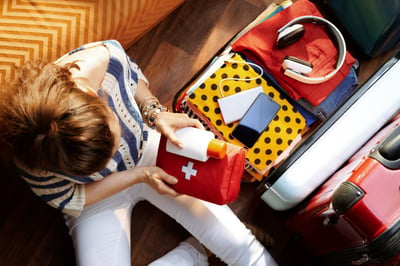Traveling Abroad with Diabetes: Have Your Dolce and Eat It Too!
 By Maria Horner
By Maria Horner
Maria shares her experiences and strategies for managing blood sugar levels while studying abroad
Like many young adults, I love to travel and will take any excuse to do so. Going into college, I knew that I wanted to study abroad; the moment I learned about my university’s semester program at their Rome campus, I was ready to go. However, traveling with diabetes isn’t always easy. The longer the trip, the more complicated it can be, and especially a trip to Italy, a country known for all of its carbohydrates!
What’s someone with diabetes to do about managing their diabetes while living in Italy?
Preparation is key!
One of the most important things I did to ensure my trip went well was put a lot of time into preparation. This means figuring out the quantity of diabetes supplies you’ll need, ordering them in advance, and finding space to pack it all. On my blog, I created a handy spreadsheet that helps you calculate exactly how much of each item you’ll need. You should start refilling your prescriptions as frequently as possible months before you travel, to make sure you stockpile enough supplies to last the whole trip. When I was preparing to go to Italy, my insurance only allowed me to order three months of supplies at one time, so I had to wait a few weeks before refilling my prescription. If you’re short on time, ask your healthcare professional if they can help you order extra supplies.
Preparation also means making back-up plans in case anything goes wrong, like talking through solutions to possible challenges. I have a great team of people that support me at home, including my parents, friends, and healthcare professionals, so before I left, I made sure I had several ways to contact them while abroad. Once I arrived in Rome, my host family, my friends, and the staff at my school became the people who could help me if I needed assistance.
Here are some things to talk about with your support team before you travel:
-
If I run out of a diabetes supply, what will I do? Can I get this supply abroad? Is having it shipped to me an option, considering what can be sent through the mail, what is allowed through customs, and the reliability of the mail system?
-
If I need to see a doctor or go to the hospital, can I find English-speaking doctors? Where is the closest hospital?
-
How does insurance work? Do I need to get special insurance while I am abroad?
-
How can I get in contact with my doctor? Can someone from my support team contact my doctor if I can’t?
Here’s a little story about how back-up supplies and my support team saved the day while I was in Rome:
About halfway through my semester, I was returning from Venice on an overnight trip and I arrived back in Rome early in the morning. I must have been sleep deprived, because I left my phone on the train! To anyone else, that would be very frustrating but manageable; most of the things people use their phones for, like email and messages, can be done on a computer. For me, it felt like a disaster, because my Dexcom G5 continuous glucose monitor (CGM) was tied to my phone. I love being able to check my blood sugar with just a glance at my phone, but without my phone, I couldn’t use my CGM. Because I’m used to constantly knowing my blood sugar, not having readings for an extended period of time was hard. Long story short, it was two days before I could get my phone back, and only with help from my support team in Rome. Thankfully, I had plenty of test strips and a blood glucose meter (BGM), so my back-up supplies came to the rescue.
Enjoy new foods, but do so in moderation.
After all my preparation, living in Rome still brought different challenges my way. Even though I wanted to experience all that Rome had to offer, I still had to keep blood sugar management in the back of my mind, especially during mealtime. Italian cuisine is full of carb-heavy foods, from pastries for breakfast to sandwiches, pizza, and pasta for lunch and dinner. Unfortunately, all these unknown carbs can make it hard to keep one’s blood sugar in range.
I didn’t want to deny myself all of the delicious, yet carb-rich, Italian foods. But I also didn’t want to drive my blood sugars out of my target range. I found that my best option was to eat these foods in moderation (just one or two bites), and fill myself up with delicious lower carb options, like vegetables and meat.
To prepare for a meal that may contain many carbs, make sure to dose extra insulin before the meal. If you end up eating more carbs than expected (which can easily happen with Italian food), the sooner you’re able to dose additional insulin – even if it means stopping in the middle of the meal to take insulin – the more quickly your blood sugars will respond.
Do some research and know what to order at restaurants.
When eating out at a restaurant, a good tactic is to order a meat, seafood, or vegetable-based dish as your main entree. Before you’re faced with ordering low-carb food in a foreign country, it’s helpful to know what you can expect from a local menu. Here’s what I learned in Italy:
-
Italian meals consist of several courses, including antipasto (appetizer), primi (the first course, typically pasta), secondi (the second course, usually meat or seafood), contorni (a side dish, usually a vegetable), and dolci (dessert).
-
Most people order either a primi or secondi as their main dish.
-
You can find the best low-carb options in the antipasti, secondi, or contorni sections of the menu.
-
If you have diabetes, ignore the primi section – it won’t be helpful for keeping your blood sugars in range.
One more tip: when you’re not sure what something is on the menu, it never hurts to ask the server or look up a picture online. This was important for me in Italy, since some of the meat dishes are breaded. I’ve included a list of my favorite low-carb Italian orders at the end of this article.
Share food with friends and family!
If you don’t want to miss out on experiencing all the pizza and pasta, get your friends to help you out. If they order a high-carb dish, ask if you can trade a few bites of your food for theirs – that way, you get to taste some pizza or pasta, while still keeping your meal low-carb. The same thing can apply to desserts, like gelato: ask a friend for a few bites, or offer to split one.
No matter what you decide to eat, just make sure you watch your blood sugars carefully, especially when trying new foods and guessing on insulin doses. Don’t let your diabetes stop you from exploring all the wonders of a new cuisine and culture, but also, don’t let impulsive food choices throw your blood sugars off. That balance can be hard to find, but do the best you can and enjoy the experience. Mangia bene (eat well)!
For more details, tips, and advice on studying abroad with diabetes, visit my blog, Winging It.
Here are some of my favorite low-carb Italian food orders, classified by course.
Antipasti (appetizers):
-
Insalata caprese (mozzarella, tomato, basil salad) – if you’re lucky, they’ll use fresh mozzarella di bufala, the most delicious cheese I’ve ever tasted!
-
Verdure grigliate misti (mixed grilled vegetables)
-
Affettato misto or salumi misti (mixed cold cuts)
-
Prosciutto (ham)
Secondi (entrees):
-
Tagliata/bistecca/filetto di manzo (beef)
-
Salsiccia (sausage)
-
Petto di pollo (chicken breast)
-
Vitella (veal)
-
Bollito alla picchiapo (beef stew in tomato sauce)
Contorni (side dishes):
-
Carciofo alla romana (roman artichoke)
-
Peperone (bell peppers)
-
Spinaci (spinach)
-
Insalata (salad)
 Maria Horner is a college student from Northern Virginia. She was diagnosed with type 1 diabetes at age seven, but she hasn’t let that hold her back! She had the incredible opportunity to study abroad in Rome during the fall of 2018, and recently started a blog about her experiences, to help and encourage other people with diabetes that are interested in studying abroad. When she’s not in class, you can find her taking a dance course or trying out a new recipe in the kitchen. She also loves travelling and going on adventures, one of her most recent adventures being skydiving!
Maria Horner is a college student from Northern Virginia. She was diagnosed with type 1 diabetes at age seven, but she hasn’t let that hold her back! She had the incredible opportunity to study abroad in Rome during the fall of 2018, and recently started a blog about her experiences, to help and encourage other people with diabetes that are interested in studying abroad. When she’s not in class, you can find her taking a dance course or trying out a new recipe in the kitchen. She also loves travelling and going on adventures, one of her most recent adventures being skydiving!







